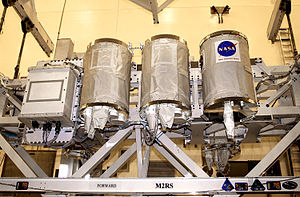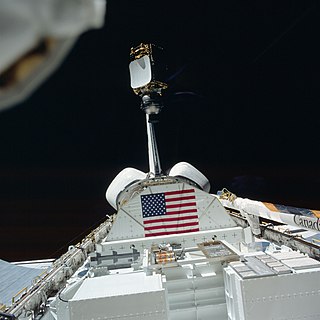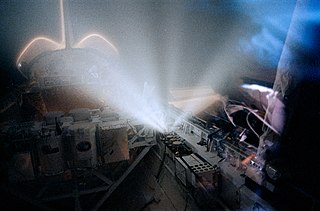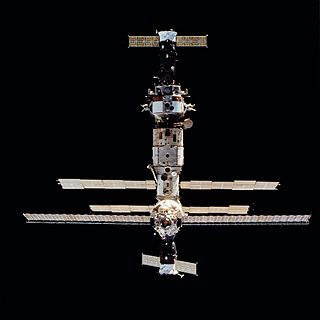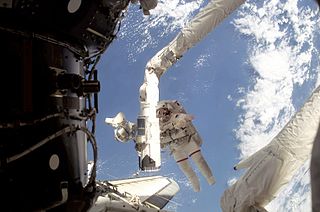Launch
Date | STS
Number | Payload
Name | Payload
Classification | Experiment
Name | Payload
Carrier
Hardware |
|---|
| 03/22/82 | 3 | GAS FVP | GAS | GAS FVP | Adapter Beam |
| 06/27/82 | 4 | G-001 | GAS | G-001 | Adapter Beam |
| 11/11/82 | 5 | G-026 | GAS | G-026 | Adapter Beam |
| 04/04/83 | 6 | G-005
G-049
G-381 | GAS | G-005
G-049
G-381 | Adapter Beam |
| 06/18/83 | 7 | G-002
G-088
G-009
G-012
G-033
G-305
G-345 | GAS | G-002
G-088
G-009
G-012
G-033
G-305
G-345 | Adapter Beam |
| 08/30/83 | 8 | G-346
G-347
G-348
G-475 | GAS | G-346
G-347
G-348
G-475 | Adapter Beam |
| 02/03/84 | 10 (41-B) | G-004
G-008
G-051
G-309
G-349 | GAS | G-004
G-008
G-051
G-309
G-349 | Adapter Beam |
| 10/05/84 | 13 (41-G) | G-007
G-013
G-032
G-038
G-074
G-306
G-469
G-518 | GAS | G-007
G-013
G-032
G-038
G-074
G-306
G-469
G-518 | Adapter Beam |
| 04/12/85 | 16 (51-D) | G-035
G-471 | GAS | G-035
G-471 | Adapter Beam |
| 04/29//85 | 17 (51-B) | G-010
G-308 | GAS | G-010
G-308 | Adapter Beam |
| 06/17/85 | 18 (51-G) | G-025
G-027
G-028
G-034
G-314
G-471 | GAS | G-025
G-027
G-028
G-034
G-314
G-471 | Adapter Beam |
| 10/30/85 | 22 (61-A) | G-308 | GAS | G-308 | Adapter Beam |
| 11/26/85 | 23 (61-B) | G-479 | GAS | G-479 | Adapter Beam |
| 01/12/86 | 24 (61-C) | HHG-1 | Hitchhiker (HH) | Particle Analysis Cameras for the Shuttle (PACS) Capillary Pump Loop (CPL) | Hitchhiker Bridge |
| 01/12/86 | 24 (61-C) | GAS Bridge Assembly-1 (GBA-1) | GAS | G-007
G-062
G-310
G-332
G-446
G-449
G-462
G-463
G-464
G-470
G-481
G-494 | GAS Bridge Assembly (GBA) |
| 08/08/89 | 28 | G-335
G-341 | GAS | G-335
G-341 | Adapter Beam |
| 10/18/89 | 34 | SSBUV-01 | GAS | Shuttle Solar Background Ultraviolet (SSBUV) | Adapter Beam |
| 12/02/90 | 35 | BBXRT | HH | Broad Band X-Ray Telescope (BBXRT) | Adapter Beam |
| 04/28/91 | 39 | MPEC-01 | CAP | Multi-Purpose Experiment Canister (MPEC) | Adapter Beam |
| 04/28/91 | 39 | STP-1 | HH | Advanced Liquid Feed Experiment (ALFE), MDACMDE/AFAL Data Systems Experiment (DSE), NASAGSFC Spacecraft Kinetic Infrared Test (SKIRT)-Circular Variable Filter(CVF) / GLOS Ultraviolet Limb Imaging Experiment (UVLIMB), NRL/USAF | Hitchhiker Bridge |
| 06/05/91 | 40 | GBA-2 | GAS | G-021
G-052
G-091
G-105
G-286
G-405
G-408
G-451
G-455
G-486
G-507
G-616 | GBA |
| 01/22/92 | 42 | GBA-3 | GAS | G-086
G-140
G-143
G-329
G-336
G-337
G-457
G-609
G-610
G-614 | GBA |
| 08/02/91 | 43 | TPCE-01 | CAP | TPCE-01 | Adapter Beam |
| 03/24/92 | 45 | G-229 | GAS | G-229 | Adapter Beam |
| 07/31/92 | 46 | CONCAP IV-03 CONCAP II-01 CONCAP III-01 | CAP | LDCE-01 LDCE-02 LDCE-03 | Adapter Beam |
| 09/12/92 | 47 | GBA-4 | GAS | G-102
G-255
G-300
G-330
G-482
G-520
G-521
G-534
G-613 | Adapter Beam |
| 11/12/93 | 51 | LDCE-04
LDCE-05 | CAP | LDCE-04
LDCE-05 | Adapter Beam |
| 10/22/92 | 52 | ASP | HH | Attitude Sensor Package (ASP) | Adapter Beam |
| 10/22/92 | 52 | TPCE-01 | CAP | TPCE-01 | Adapter Beam |
| 12/02/92 | 53 | GCP | HH | Orbital Debris Radar Calibration Spheres (ODERACS-1) Cryogenic Heat Pipe Experiment (CRYOHP) Shuttle Glow (GLO-1) | Adapter Beam |
| 01/13/93 | 54 | DXS | HH | Diffuse X-ray Spectrometer (DXS) | Adapter Beam |
| 04/26/93 | 55 | RKGM | CAP | RKGM | Adapter Beam |
| 04/08/93 | 56 | SUVE | CAP | SUVE | Adapter Beam |
| 06/21/93 | 57 | SHOOT | HH | Super Fluid Helium On Orbit Transfer (SHOOT) | Adapter Beam |
| 06/21/93 | 57 | GBA-5 | GAS | CONCAP-IV-01
G-022
G-324
G-399
G-450
G-452
G-453
G-454
G-535
G-601
G-647 | GBA |
| 04/09/94 | 59 | CONCAP IV-02 | CAP | CONCAP IV-02 | Adapter Beam |
| 04/09/94 | 59 | G-203
G-300
G-458 | GAS | G-203
G-300
G-458 | Adapter Beam |
| 02/03/94 | 60 | COB/GBA ODERACS-1R BREMSAT | GAS Bridge Assembly-6 with Hitchhiker Avionics | Capillary Pumped Loop (CAPL), NASA GSFC | GBA w/ HH Avionics |
| 02/03/94 | 60 | COB/GBA ODERACS-1R BREMSAT | HH | Orbital Debris Radar Calibration Spheres (ODERACS-1R), USAF | GBA w/ HH Avionics |
| 02/03/94 | 60 | COB/GBA ODERACS-1R BREMSAT | CAP | BREMAN Satellite (BREMSAT), University of Bremen | GBA w/ HH Avionics |
| 02/03/94 | 60 | COB/GBA ODERACS-1R BREMSAT | GAS | G-071
G-514
G-536
G-557 | GBA w/ HH Avionics |
| 03/04/94 | 62 | LDCE-06 LDCE-07 LDCE-08 | CAP | LDCE-06LDCE-07 LDCE-08 | Adapter Beam |
| 03/04/94 | 62 | OAST-2 | HH | Thermal Energy Storage (TES-1, TES-2) Cryogenic Two Phase (CRYOTP), NASA GSFC/USAF Phillips Lab Emulsion Chamber Technology (ECT), NASA MSFC Experimental Investigation of Spacecraft Glow (EISG), NASA JSC/NASA GSFC Solar Array Module Plasma Interaction Experiment (SAMPIE), NASA LeRC Spacecraft Kinetic Infrared Test (SKIRT), NASA JSC/NASA GSFC | HH Bridge |
| 02/03/95 | 63 | CGP/ODERACS-2 | HH | Cryo System Experiment (CSE), Hughes Shuttle Glow (GLO-2), U of AZ IMAX Cargo Bay Camera (ICBC) Orbital Debris Radar Calibration System-II (ODERACS-II), USAF | HH Bridge |
| 09/09/94 | 64 | ROMPS-1 | HH | Robot Operated Materials Processing System (ROMPS) | Adapter Beam |
| 09/09/94 | 64 | GBA-7 | GAS | G-178
G-254
G-325
G-417
G-453
G-454
G-456
G-485
G-506
G-562 | GBA |
| 11/03/94 | 66 | ESCAPE-2 | CAP | ESCAPE-2 | Adapter Beam |
| 03/02/95 | 67 | G-387
G-388 | GAS | G-387
G-388 | Adapter Beam |
| 09/30/94 | 68 | G-316
G-503
G-541 | GAS | G-316
G-503
G-541 | Adapter Beam |
| 09/07/95 | 69 | IEH-1 | HH | Ultraviolet Spectrograph Telescope for Astronomical Research (UVSTAR), U of AZ/ESA Shuttle Glow Experiment-3 (GLO-3), U of AZ
Solar Extreme Ultraviolet HH (SEH), USC | HH Bridge |
| 09/07/95 | 69 | IEH-1 | HH-Jr. | Complex Autonomous Payload (CONCAP IV-03), U of AL | HH Bridge |
| 09/07/95 | 69 | CAPL/GBA | HH | Capillary Pumped Loop (CAPL-2), NASA/GSFC | GBA |
| 09/07/95 | 69 | CAPL/GBA | CAP | TES-2 | GBA |
| 09/07/95 | 69 | CAPL/GBA | GAS | G-515
G-645/SRE
G-702/SRE
G-726 | GBA |
| 01/11/96 | 72 | SLA-01 | HH | Shuttle Laser Altimeter-01 (SLA-01), NASA/GSFC | HH Bridge |
| 01/11/96 | 72 | SLA-01 | CAP | TES-2 | HH Bridge |
| 01/11/96 | 72 | SLA-01 | GAS | G-342
G-459
G-740 | HH Bridge |
| 01/11/96 | 72 | SLA-01 | HH | Shuttle Laser Altimeter-01 (SLA-01), NASA/GSFC | HH Bridge |
| 11/12/95 | 74 | GPP | HH | Shuttle Glow Experiment (GLO-4) Photogrammetric Appendage Structural Dynamics Experiment Payload (PASDE-01) | Adapter Beam |
| 03/22/96 | 76 | G-312 | GAS | G-312 | Adapter Beam |
| 05/19/96 | 77 | TEAMS | HH | Vented Tank Resupply Experiment (VTRE), NASA/LeRC GPS Attitude and Navigation Experiment (GANE), NASA/JSC Liquid Metal Thermal Experiment (LMTE), USAF Phillips Laboratory Passive Aerodynamically-Stabilized Magnetically-Damped Satellite (PAMS), NASA GSFC | HH Bridge |
| 05/19/96 | 77 | TPCE-RF | CAP | TPCE-RF | GBA |
| 05/19/96 | 77 | G-056
G-063
G-142
G-144
G-163
G-200
G-490
G-564
G-565
G-703
G-741 | GAS | G-056
G-063
G-142
G-144
G-163
G-200
G-490
G-564
G-565
G-703
G-741 | GBA |
| 11/19/96 | 80 | SEM-01 | SEM | SEM-01 | Adapter Beam |
| 04/04/97 | 83 | CRYOFD | HH | Cryogenic Flexible Diode (CRYOFD), NASA GSFC/USAF Phillips Lab | Adapter Beam |
| 08/07/97 | 85 | TAS-01 | HH | Shuttle Laser Altimeter (SLA-02), NASA GSFC Infrared Spectral Imaging Radiometer (ISIR), NASA GSFC Critical Viscosity of Xenon (CVX-01), NASA LeRC Space Experiment Module (SEM-02), NASA GSFC Solar Constant (SOLCON-1), Royal Meteorological Institute of Belgium Two-Phase Flow (TPF), NASA GSFC COOLLAR Flight Experiment (CFE), USAF Phillips Lab | HH Bridge |
| 08/07/97 | 85 | TAS-01 | SEM | SEM-02 | HH Bridge |
| 08/07/97 | 85 | IEH-2 | HH | Ultraviolet Spectrograph Telescope for Astronomical Research (UVSTAR), U of AZ/ESA Shuttle Glow Experiment-5 & 6 (GLO-5 & 6), U of AZ Solar Extreme Ultraviolet Hitchhiker (SEH), USC Distribution and Automation Technology Advancement - Colorado Hitchhiker And Student Experiment of solar Radiation (DATA-CHASER), University of Colorado | HH Bridge |
| 08/07/97 | 85 | G-572
G-745 | GAS | G-572
G-745 | Adapter Beam |
| 19/25/97 | 86 | SEEDSII | CAP | SEEDSII | Adapter Beam |
| 11/19/97 | 87 | LHP/NaSBE (LNBP) | HH | Loop Heat Pipe Experiment (LHP), Dynatherm Sodium Surface Battery Experiment (NaSBE), NRL | Adapter Beam |
| 11/19/97 | 87 | SOLSE-01 | HH-Jr | Shuttle Ozone Limb Sounding Experiment (SOLSE-01), NASA GSFC | Adapter Beam |
| 11/19/97 | 87 | TGDF | CAP | TGDF | Adapter Beam |
| 11/19/97 | 87 | G-036 | GAS | G-036 | Adapter Beam |
| 12/04/98 | 88 | MIGHTYSAT-1 | HH | MightySat-1, USAF Phillips Lab Satellite de Aplicaciones Cientifico-A (SAC-A), Argentinean National Commission of Space Activities | Adapter Beam |
| 12/04/98 | 88 | JSC APFR | HH | JSC APFR | Adapter Beam |
| 12/04/98 | 88 | G-093R | GAS | G-093R | Adapter Beam |
| 12/04/98 | 88 | SEM-07 | SEM | SEM-07 | Adapter Beam |
| 01/22/98 | 89 | G-093
G-141
G-145
G-432 | GAS | G-093
G-141
G-145
G-432 | Adapter Beam |
| 04/17/98 | 90 | SVF-01 | CAP | Shuttle Vibration Forces (SVF), NASA JPL | Adapter Beam |
| 04/17/98 | 90 | G-197
G-744
G-772 | GAS | G-197
G-744
G-772 | Adapter Beam |
| 06/02/98 | 91 | G-090
G-648
G-743
G-765 | GAS | G-090
G-648
G-743
G-765 | Adapter Beam |
| 06/02/98 | 91 | SEM-03
SEM-05 | SEM | SEM-03
SEM-05 | Adapter Beam |
| 07/01/97 | 94 | CRYOFD | HH | Cryogenic Flexible Diode (CRYOFD) | Adapter Beam |
| 10/29/98 | 95 | CRYOTSU | HH | Cryogenic Thermal Storage Unit (CRYOTSU), NASA GSFC | Adapter Beam |
| 10/29/98 | 95 | IEH-3 | HH | Ultraviolet Spectrograph Telescope for Astronomical Research (UVSTAR), U of AZ/ESA Solar Extreme Ultraviolet Hitchhiker (SEH), USC STAR-LITE, U of AZ Petite Amateur Navy Satellite (PANSAT), USAF Space Test Program Solar Constant Experiment (SOLCON-02), Royal Meteorological Institute of Belgium | HH Bridge |
| 10/29/98 | 95 | IEH-3 | GAS | G-238
G-764 | HH Bridge |
| 10/29/98 | 95 | SEM-04 | SEM | SEM-04 | SEM-attached to SPARTAN 201-05 Bridge |
| 10/29/98 | 95 | G-467
G-779 | GAS | G-467
G-779 | Adapter Beam |
| 05/27/99 | 96 | SVF-02 | CAP | Shuttle Vibration Forces (SVF-02), NASA JPL | Adapter Beam |
| 05/27/99 | 95 | STARSHINE | HH | Student Tracked Atmospheric Research Satellite for Heuristic International Networking Experiment (STARSHINE), Rocky Mountain NASA Space Grant Consortium/USU | Adapter Beam |
| 05/19/00 | 101 | MARS | CAP | MARS | Adapter Beam |
| 05/19/00 | 101 | SEM-06 | SEM | SEM-06 | Adapter Beam |
| 03/08/01 | 102 | WSVFM | CAP | Wide-band Shuttle Vibration Force Measurement (WSVFM), NASA JPL | Adapter Beam |
| 03/08/01 | 102 | G-783 | GAS | G-783 | Adapter Beam |
| 03/08/01 | 102 | SEM-09 | SEM | SEM-09 | Adapter Beam |
| 03/08/01 | 102 | Beam - Bay 4 | Beam - Contingency I | Beam - Bay 4 | Adapter Beam |
| 08/10/01 | 105 | HEAT | HH | Advance Carrier Equipment (ACE) SimpleSat, NASA/GSFC | Adapter Beam |
| 08/10/01 | 105 | HEAT | GAS | G-774 | Adapter Beam |
| 08/10/01 | 105 | HEAT | SEM | SEM-10 | Adapter Beam |
| 08/10/01 | 105 | G-780 | GAS | G-780 | Adapter Beam |
| 08/10/01 | 105 | HEAT | Beam - Bay 4 Port | Beam for Contingency | Adapter Beam |
| 09/08/00 | 106 | G-782 | GAS | G-782 | Adapter Beam |
| 09/08/00 | 106 | SEM-08 | SEM | SEM-08 | Adapter Beam |
| 11/29/02 | 107 | FREESTAR | HH | Mediterranean Israeli Dust Experiment (MEIDEX), Israeli Space Agency Solar Constant Experiment (SOLCON-03), Royal Meteorological Institute of Belgium Shuttle Ozone Limb Sounding Experiment (SOLSE-2), NASA GSFC Critical Viscosity of Xenon (CVX-2), NASA GRC Low Power Transceiver (LPT), NASA GSFC and ITT Industries SEM-14 | HH Bridge |
| 12/05/01 | 108 | MACH-1 | HH | CAPL-3, NASA GSFC and the Naval Research Laboratory STARSHINE-2, Rocky Mountain NASA Space Grant Consortium / USU Prototype Synchrotron Radiation Detector (PSRD), NASA JSC | GBA with HH Avionics |
| 12/05/01 | 108 | MACH-1 | CAP | Collisions Into Dust Experiment (COLLIDE-2), NASA GRC | GBA with HH Avionics |
| 12/05/01 | 108 | MACH-1 | GAS | G-761 | GBA with HH Avionics |
| 12/05/01 | 108 | MACH-1 | SEM | SEM-11
SEM-15 | GBA with HH Avionics |
| 12/05/01 | 108 | LMC | LMC Carrier | SEM-12
G-064
G-730
G-785 | LMC Carrier |
| 12/05/01 | 108 | G-221
G-775 | GAS | G-221
G-775 | Adapter Beam |

